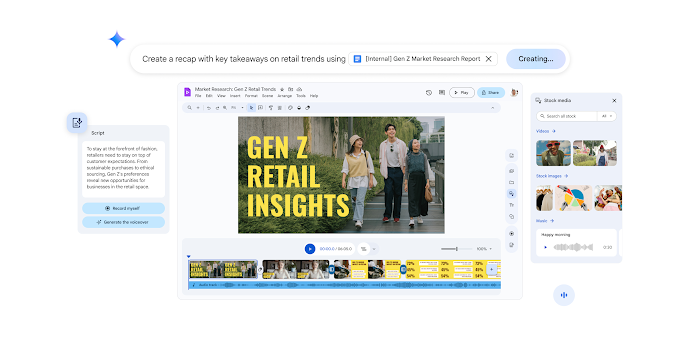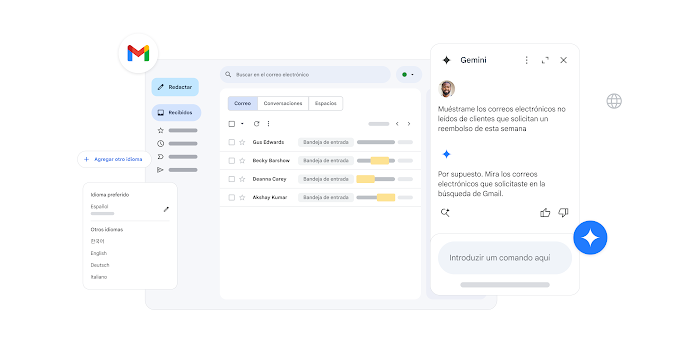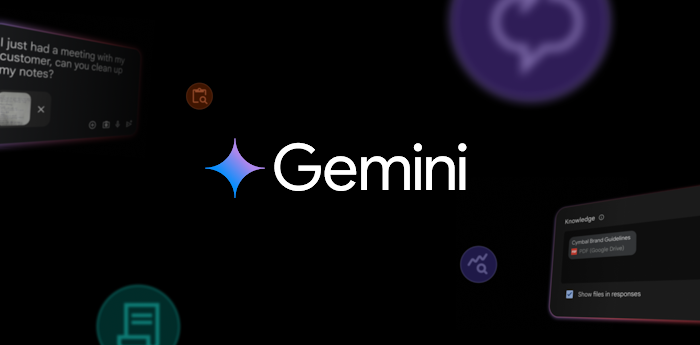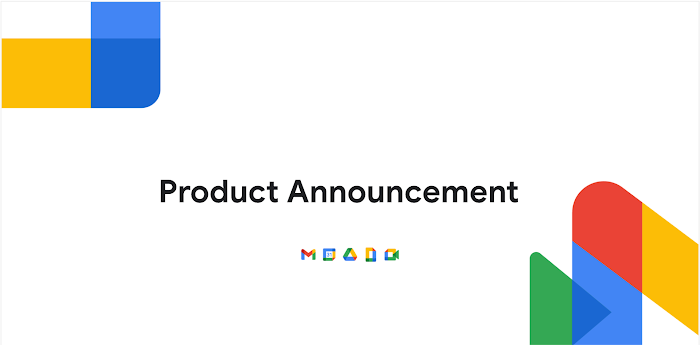Helping businesses work faster, smarter and more collaboratively in G Suite

David Thacker
Vice President, Product and Design, G Suite
Today we announced updates to our set of intelligent productivity and collaboration apps at Cloud Next '19.
Try Google Workspace at No Cost
Get a business email, all the storage you need, video conferencing, and more.
SIGN UPFrom organizations that have operated for more than a century, to companies born in the digital age, to entrepreneurs just starting to get their business off the ground—G Suite is helping people work faster, smarter and more collaboratively than ever before. Today we announced updates to our set of intelligent productivity and collaboration apps at Cloud Next '19. Here’s a complete list of what’s new—read more detail below.
- G Suite integration with Google Assistant (beta)
- G Suite Add-ons (beta coming soon)
- Cloud Search (generally available for eligible customers)
- Drive metadata (beta)
- Hangouts Meet updates: automatic live captions (generally available), public live streaming (coming soon) and increased meeting participants (coming soon)
- Connected sheets (beta coming soon)
- Google Voice for G Suite (generally available)
- Hangouts Chat into Gmail (beta)
- Office editing in Docs, Slides and Sheets (generally available)
- Visitor sharing in Drive (beta)
- Currents (beta)
- Access Transparency (generally available)
- Enhancements to data regions for G Suite (generally available)
- Security collaboration and automation (beta)
Make it fast
Agility is core to being able to compete in a changing market, which means your team needs tools to help them move faster. The following updates in G Suite can help you work more efficiently and spend less time on repetitive, predictable tasks.
- First, G Suite is integrating with the Google Assistant, specifically with Calendar. Your Google Assistant already helps with your personal life, but now when you sign in and switch to your G Suite account, you can easily use your Assistant to help you prepare for the work day, too. Whether you’re at home, on the go, or in the car, you’ll be able to ask your Assistant to tell you when and where your next meeting is, and stay on top of scheduling changes. This integration is available in beta today.
- Next, G Suite Add-Ons, which provides a way for people to access their favorite workplace apps in the G Suite side panel to complete tasks, instead of toggling between multiple apps and tabs. Employees can now consult a CRM tool for information while drafting a Google Doc, add tasks into a project management tool straight from an email in Gmail, and more. Today, we’re introducing new G Suite Add-ons to help you keep work flowing, including Copper, Workfront, Box, and others. Sign up for the beta which will become available in the coming months.
- We’re also launching new ways to find files faster and easier in Drive with Drive metadata. G Suite admins, and their delegates, can create metadata categories and taxonomies to make content more discoverable in search. This way, employees can apply metadata to any file in Drive and minimize the time it takes to track down a document, all the while helping your organization maintain more granular governance. Sign up for Drive metadata which is available in beta today.
Make it smart
Employees need access to relevant information to make confident, well-informed decisions. The following updates in G Suite can help your organization work smarter.
- First, we’re bringing third-party connectivity in Cloud Search to eligible G Suite Enterprise customers. Two years ago, we introduced Cloud Search to help employees search—and find—every digital asset and person in their company. Last year, we started offering Cloud Search as a standalone solution, so that even businesses who have not yet moved to G Suite can use the power of Google Search in their company. As a part of the standalone offering, we made it possible for businesses to search third-party data sources, like SAP and Salesforce. Learn more.
- We’re making updates to Hangouts Meet to help make your meetings more productive and to help large businesses stay connected. First, you can turn on automatic live captions now, powered by Google’s speech recognition technology, during video meetings. For hearing impaired, non-native language participants or even noisy rooms, live captioning ensures everyone can follow along. This Meet feature is generally available today in English. Second, we’re making live streaming in Meet publicly available. We first announced live streaming capabilities for up to 100,000 viewers last year. Building on this, you’ll soon be able to let attendees outside of your organization view a livestream by listing it as “public.” Lastly, we’re making it possible for up to 250 people to join meetings in Meet soon. Learn more about Meet on our website.
- People are used to using spreadsheets and pivot tables to analyze data, but this can be difficult when you're working with large, complicated datasets. Now a new feature in Sheets, called connected sheets, lets you collaborate on up to 10 billion rows of BigQuery data right from within Sheets (without needing SQL!). View your company’s BigQuery data quickly in the user-friendly Sheets interface and analyze it with formulas and pivot tables, or even visualize it with charts. Sign up for the beta of connected sheets which will become available in the next few months.
Make it together
At Google, we know that a collaborative culture brings out the best ideas, so it’s critical for teams to have tools that work well together. The following updates in G Suite can help you work together, no matter the tool or location (and keep interruptions at a minimum).
- First, Voice is now generally available to G Suite customers in select markets. Voice is a cloud telephony service that gives you a phone number that works from anywhere, on any device. With Google’s AI built in, Voice can help you transcribe voicemails and block spam calls. Voice also uses text-to-speech technology to automatically create call menus in up to nine languages, so that you don't have to worry about recording messages or translation. Lastly, Voice is easy for admins to provision and manage, since it takes care of number assignment, porting and billing. Learn more.
- You might know that we’ve evolved classic Hangouts to focus on two experiences that bring teams together: Hangouts Chat and Hangouts Meet. We’ve seen great adoption with both tools among G Suite customers, and today we’re bringing Hangouts Chat into Gmail. Now all of your team communications can easily be accessed in one place on your desktop—the lower left section of Gmail will highlight people, rooms, and bots. Rooms open up into full screen experiences with threads. Click here to express interest in the upcoming beta for Chat in Gmail.
- People work with all sorts of tools to get work done, which is why we’re making it possible to collaborate in real-time in Microsoft Office, just like you do in G Suite. With Office editing in Docs, Sheets and Slides, you can work on Office files straight from G Suite without having to worry about converting file types—helpful if you interact with external clients, or even internal teams, who use Office (Bonus: this also makes it possible to tap into G Suite intelligence, like using AI-powered grammar suggestions.). Office editing will roll out in coming weeks—learn how you can get started in our Help Center article.
- It’s important that your technology makes it easy to collaborate with people outside of your company—clients, external stakeholders, it takes a village to drive projects. That’s why we’re making it easier to share files stored in Drive with people who don’t have a Google account, just like you already share with those who do. Visitor sharing in Drive is a simple way for you to invite others to collaborate on files in G Suite using pincodes. Visitors who have the pincode can view, comment, suggest edits, and directly edit Docs, Sheets, and Slides, as well as other file types like PDFs and Microsoft Office files. Learn more about visitor sharing in Drive which is currently available in beta.
- And Currents, which is the new name for the enterprise version of Google+, is a way for employees to share knowledge and engage in meaningful discussions with others across their organization, regardless of title or geography. On Currents, employees can easily see discussions that are trending in their organization and follow topics of interest. Currents is available in beta today—read this blog post or visit our website for more details.
Make it work for enterprises
We’re committed to bringing businesses tools that provide transparency, and that can help them confidently—and simply—secure their data. The following updates in G Suite give enterprises more ways to effectively manage access to data, identify security issues and work together to remediate.
- First, Access Transparency, which gives G Suite customers access to logs of actions taken by Google staff, as well as the reason for each access (like references to specific support tickets). As a result, you can verify that Google is accessing your data only for valid business reasons, and you can use this information in support of audits as needed. Learn more about Access Transparency in this blog post. Next, we’re enhancing data regions with coverage for backups. For organizations with stringent control requirements, data regions for G Suite now lets you choose where covered data at rest, including backups, should be stored—globally distributed, US, or in Europe. Learn more about data regions in this blog post. Both of these enhancements, Access Transparency and data regions for G Suite, are generally available today.
- We’re also bringing admins additional ways to assess their organization’s exposure to security issues, and to work together to remediate. Now admins can create rules to automate alerts and take actions, as well as save and share investigations directly within the security center investigation tool. We’ve also made it possible for admins to indicate alert status, decide on the severity of an issue and assign alerts to other admins, all within the alert center. This can help teams of admins and analysts take ownership of alerts and provide immediate status updates as they work through security investigations. Sign up for the security center beta here and the alert center beta here. To learn more about other Google Cloud security updates at Next ‘19, check out this blog post.
More than 5 million businesses are already using G Suite to work faster, smarter and more collaboratively. Visit our website to learn more.



